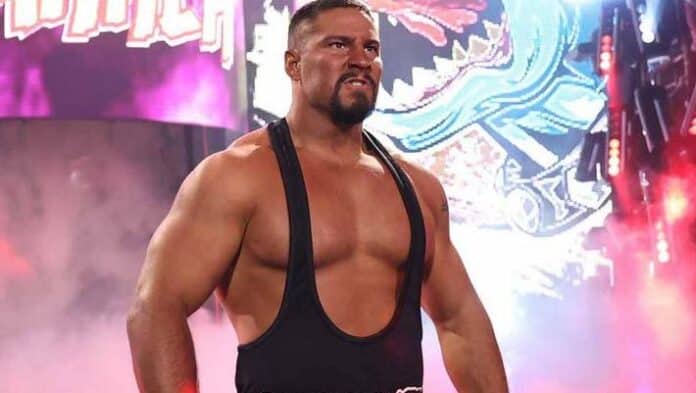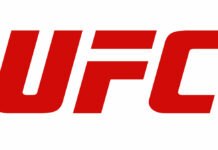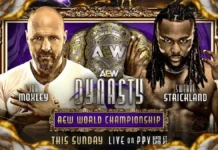
Title Tuesday, All Elite Wrestling’s chance to go head-to-head with NXT for the first time in a few years, brings with it questions about not only competition in the industry, but also the status of the NXT brand as a whole. Make no mistake about it, the developmental brand was originally put on television to attempt to snuff out Dynamite before the prospect of an alternative product could get off the ground. As we know, WWE brass took the initial concept seriously, as they offered inflated contracts to talent just to keep them away from All Elite, and of course, released a lot of those same performers after not only the pandemic shut the world down, but also when it became clear that the Tony Khan-owned project wasn’t nearly the threat that it looked to be on paper before the launch. Don’t get me wrong, the office was right to attempt to shrink the free agent market before a new venture started because a billionaire with enough funding to start a national promotion with a weekly live touring schedule could theoretically have the resources to make a dent in the WWE market share. As we know, for a slew of reasons, All Elite didn’t get close to the 1.4 million viewers it had for the debut edition of Dynamite again and as the story of AEW has unfolded over the past four years, the organization is more of a niche product than competition for WWE, especially after the TKO merger.
Still, the WWE didn’t get to the point where it could be a part of such a massive merger without being a dominate business entity. After they signed away Cody Rhodes a few years ago, and more recently, made Jade Cargill seem like a bigger star in two weeks than AEW did in two years, the Tuesday head-to-head ratings clash is another opportunity for the WWE machine to make a definitive statement about its status as the king of sports entertainment.
Paul Heyman will be in the corner of Bron Breakker, and the possibilities of such a highly-touted prospect to be paired with Heyman has a much bigger payoff than just a one-off ratings win. John Cena, truly one of the greatest of all time, will be in the other corner for Carmelo Hayes. Cody Rhodes was advertised to make an announcement, and Asuka wrestle on the show. Plus, Becky Lynch is scheduled for the show, while she still works Raw regularly. It goes without saying the WWE wants to send a message that Edge can make the jump to collect the big payday (as he should) but it won’t be comparable to the massive star power that the publicly-traded corporation can offer casual fans.
I don’t think it would be a surprise if NXT beats Dynamite in the ratings, but aside from an ego boost to WWE brass, a one-week ratings win doesn’t translate to all that much. The WWE will continue its run of record-setting profitability the next few years, and AEW will hopefully continue to be a profitable niche product.
The bigger story might be, what exactly does all of this mean for the NXT brand?
I have to be honest, while I understand that NXT was put on USA network to attempt to chip away at Dynamite viewership, the concept of a developmental brand on national television is still completely counterproductive. In some respects, when the show was still on the WWE Network, with a smaller audience than the television programming, it served its purpose, as the goal wasn’t ratings, and the existence of the show was a perk, not a selling point of network subscriptions. The live pay-per-views and the extensive video library were what generated subscribers when the streaming service launched in 2014. If a developmental talent made mistakes on a smaller scale, it was simply a part of the process and didn’t expose them to a main stream audience. Furthermore, if a talent was given television time and eventual fizzled out, the investment from the company was minimal since it wasn’t on the main roster.
Now, more often than not, NXT looks to be an attempt at a third brand, but still lacks the key components to solidify that status. Again, in theory, the developmental brand on national TV risks exposing the mistakes of younger talent, which puts them in a tough spot. Furthermore, national television is based on ratings and ad revenue so the overall goal can’t be just how to get the talent ready for the main roster, but rather how to book the show to make it a successful television venture.
However, the biggest hurdle for the concept of a third brand for the main roster might simply be the dynamics of supply and demand. At a time when there are more entertainment options than there were in any era previously, is there a demand for more WWE programming? Raw is three hours, Smackdown is two hours, and when there’s a pay-per-view scheduled it’s roughly three and a half hours. The five hours of main roster weekly content is arguably too much, as Raw usually has a dip in the ratings in the third hour. Is there really a demand for seven hours of main roster TV if NXT is added to the line-up?
I don’t think so, but with the new upcoming television deals, it would be wise for management to try to boost NXT’s numbers as an added incentive when they negotiate a new contract for Raw. They had Dominik Mysterio work NXT in recent months and the addition of Becky Lynch gives the show a boost of legitimate star power. The fact that more established stars are involved, it might be an attempt to reconstruct the basis of the brand.
That being said, outside of the supply and demand aspect of WWE programming, the other problem that goes along with a scenario to try to boost the NXT brand is that for years, performers that were very successful on the developmental show didn’t translate to the main roster. It become clear that the storylines and the stars of NXT were secondary in the grand scheme of things. The office would have to establish that success in NXT has some level of impact on Raw or Smackdown.
Finally, in terms of individual career paths, the developmental brand, especially since it was put on television almost unintentionally hindered the progress of stars that were already polished pros. Shinsuke Nakamura and Samoa Joe are just two examples of guys that spent a few years of their careers on the developmental brand when they already had the ability to be a draw on the main roster. Right now, the argument could be made that Bron Breakker is potentially wasting years of the prime of his career on a smaller scale when he could be a major star if he was given the chance to shine on the main roster.
Again, “Title Tuesday” is just a one-off in terms of a ratings competition, but the bigger story could be that it might provide a blue print for WWE management if they attempt to boost NXT as a third brand instead of the developmental system.
What do you think? Share your thoughts, opinions, feedback, and anything else that was raised on Twitter @PWMania and Facebook.com/PWMania.
Until next week
-Jim LaMotta
E mail [email protected] | You can follow me on Instagram, Facebook, & Threads @jimlamotta89







